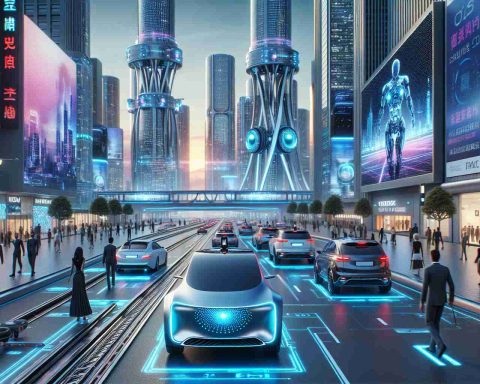Navigating the Future with Autonomous Vehicles
In a world increasingly dominated by technological advancements, the recent vehicular disaster in San Francisco offers a poignant reflection on the future of autonomous vehicles. The unsettling incident echoes a broader question: as cities grow denser, how can we ensure road safety amidst burgeoning autonomous technology?
On a recent Sunday evening, the intersection of 6th and Harrison Streets in San Francisco became the stage for a disastrous seven-car pileup. This tragedy not only resulted in the unfortunate loss of human and animal life but also included an empty Waymo autonomous car in its unfolding. While not directly contributing to the crash, the involvement of the autonomous vehicle compels us to scrutinize the safety benchmarks of self-driving technology.
Addressing Automation and Accountability
With the projected market for autonomous vehicles set to skyrocket past $600 billion by 2026, the San Francisco incident adds fuel to the debate around driverless technology and its integration within society. While the safety features of autonomous vehicles promise reduced collisions and fewer errors, incidents like these intensify public apprehension and demand greater accountability.
Rethinking Urban Infrastructure
The broader implications extend to urban infrastructure and road safety. With emergency services overwhelmed by the magnitude of response required, the need for enhanced preparedness couldn’t be clearer. Urban centers must prioritize investments in pedestrian safety and robust public transport systems to mitigate the risks posed by both human and automated elements on the road.
The pressing question remains: as we tread into the era of automation, how ready is our society to balance innovation with safety? The answer could redefine how cities and their inhabitants adapt to rapid technological transformation.
The Environmental Impact of Autonomous Vehicles: Shaping a Sustainable Future
The inclusion of autonomous vehicles (AVs) in the San Francisco vehicular disaster highlights significant challenges and potential benefits of this burgeoning technology. As we contemplate the implications of driverless cars, one critical factor to consider is their environmental impact, which holds substantial promise for a more sustainable future.
Autonomous vehicles have the potential to revolutionize transportation by minimizing traffic congestion, improving fuel efficiency, and reducing carbon emissions. These vehicles are designed to communicate with each other and with the surrounding infrastructure, allowing for optimized travel routes and reduced idle times. Consequently, this could lead to less energy consumption and lower emission levels in densely populated urban areas.
Moreover, autonomous vehicles can foster an environment conducive to the wider adoption of electric vehicles (EVs). Many AV manufacturers are developing their fleets with electric powertrains, aligning with global efforts to combat climate change by transitioning away from fossil fuels. Integration of autonomous and electric technologies could significantly decrease the transportation sector’s carbon footprint, a primary contributor to global warming.
Additionally, an automated transport system could potentially reduce the need for personal car ownership. This shift could result in fewer cars manufactured and a decrease in resource extraction, pollution, and waste associated with vehicle production and disposal. In urban landscapes, decreased demand for parking spaces could free up land for green spaces, further contributing to urban sustainability.
However, to fully harness these environmental benefits, cities must invest in robust infrastructure and intelligent traffic management systems that support an autonomous ecosystem. This would include smart grids to charge electric AVs efficiently and resilient data networks to facilitate inter-vehicle and infrastructure communication without inadvertently increasing energy demand.
The transition to autonomous vehicles presents a golden opportunity to reshape transportation systems to align with sustainability goals. As society stands at the cusp of this technological revolution, ensuring that autonomous technology is integrated with environmental considerations will play a crucial role in securing a greener future for humanity. Balancing technological advancement and ecological conservation will be instrumental in navigating the path towards a sustainable and equitable world.
Exploring the Future: How Autonomous Vehicles Could Drive Safer, Smarter Cities
Navigating the Path Forward with Autonomous Vehicles
As cities around the globe grapple with increasing congestion and the challenges of urbanization, autonomous vehicles (AVs) emerge as a potential solution to transform urban mobility. The recent event in San Francisco has intensified the conversation about how this technology can be deployed safely and effectively.
Industry Innovations and Integrations
The autonomous vehicle industry is not static; it is characterized by constant innovation. Companies are investing heavily in technologies such as machine learning, AI-driven navigation, and advanced sensor systems. These advancements aim to make AVs smarter and more reliable, reducing the potential for accidents and improving traffic flow.
Moreover, autonomous vehicles are being tested for various purposes beyond personal transport, including delivery services and public transit. These use cases could significantly reduce the carbon footprint of urban centers by optimizing routes and reducing idle times.
Pros and Cons: Balancing Innovation with Safety
Pros:
– Reduction in Human Error: With advanced algorithms, AVs promise to minimize accidents caused by distracted or impaired driving.
– Improved Traffic Flow: Autonomous systems can communicate with each other to optimize speed and reduce congestion.
– Environmental Benefits: Electric AVs can contribute to reduced emissions, promoting a cleaner urban environment.
Cons:
– Technology Dependency: Over-reliance on technology may create new vulnerabilities, such as software malfunctions or hacking.
– Ethical Dilemmas: Decision-making in critical situations, such as unavoidable accidents, raises ethical questions.
– Infrastructure Costs: Significant investments are required to update urban infrastructure to accommodate AVs.
Market Predictions and Insights
The AV market’s trajectory points toward rapid growth, with projections surpassing $600 billion by 2026. This expansion is driven by increasing consumer interest, government incentives, and advancements in autonomous technology. The market’s evolution suggests that cities prepared to integrate AVs with existing transit systems may gain significant competitive advantages.
Urban Infrastructure: Preparing for Autonomous Integration
To safely integrate autonomous vehicles into urban environments, cities must undergo infrastructural upgrades. This includes smart traffic signals, dedicated AV lanes, and enhanced public transit options. Investments in these areas will not only support AVs but also improve overall urban mobility.
Security and Compatibility
A critical aspect of rolling out autonomous vehicles is ensuring robust cybersecurity measures are in place. Protecting these vehicles from malicious attacks is paramount for public trust and safety. Additionally, ensuring compatibility with current transportation systems and regulations will be a decisive factor in the widespread adoption of AVs.
For a deeper insight into how universities and research institutions collaborate with the automotive industry, and the role of policy-making in shaping AV technology, visit Waymo.
Final Thoughts: The Future of Autonomous Vehicles
As we look towards a future dominated by automation, it is crucial to strike a balance between technological progression and societal readiness. Thorough research, strategic investments, and community engagement will be instrumental in ensuring autonomous vehicles enhance urban living while safeguarding public safety.








